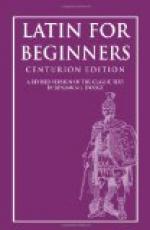383. The verb fi:o:\, _be made, happen_, serves as the passive of facio:\, make, in the present system. The rest of the verb is formed regularly from facio:\. Learn the principal parts and conjugation (Sec. 500). Observe that the i\ is long except before -er and in fit\.
a. The compounds of
facio\ with prepositions usually form the
passive regularly, as,
Active conficio, conficere,
confeci, confectus
Passive conficior, confici, confectus
sum
[ Conjugation given in Sec. 500:
PRINCIPAL PARTS fi:o:, fieri:, factus sum\
INDICATIVE SUBJUNCTIVE IMPERATIVE Pres. fi:o: —— fi:am 2d Pers. fi: fi:te fi:s —— fit fi:unt Impf. fi:e:bam fierem Fut. fi:am ——
INDICATIVE SUBJUNCTIVE Perf. factus, -a, -um sum factus, -a, -um sim Plup. factus, -a, -um eram factus, -a, -um essem F. P. factus, -a, -um ero:
INFINITIVE PARTICIPLES Pres. fieri: Perf. factus, -a, -um Perf. factus, -a, -um esse Ger. faciendus, -a, -um Fut. [[factum i:ri:]]]
384. Observe the following sentences:
1. Terror erat tantus ut omnes fugerent,
the terror was so great
that all fled.
2. Terror erat tantus ut non facile
milites sese reciperent, the
terror was so great that the soldiers
did not easily recover
themselves.
3. Terror fecit ut omnes fugerent,
terror caused all to flee
(lit. made that all fled).
a. Each of these sentences
is complex, containing a principal
clause and a subordinate clause.
b. The principal clause
names a cause and the subordinate clause
states the consequence
or result of this cause.
c. The subordinate clause has its verb in the subjunctive, though it is translated like an indicative. The construction is called the subjunctive of consequence or result, and the clause is called a consecutive or result clause.
d. In the last example
the clause of result is the object of the
verb fecit\.
e. The conjunction
introducing the consecutive or result clause is
ut\ = _so that_; negative,
ut no:n\ = so that not.
385. RULE. Subjunctive of Result. Consecutive clauses of result are introduced by /ut\ or /ut no:n\ and have the verb in the subjunctive.
386. RULE. Object clauses of result with /ut\ or /ut no:n\ are found after verbs of /effecting\ or /bringing about\.




